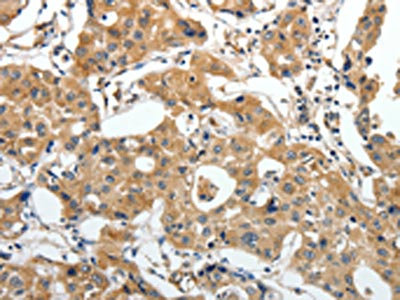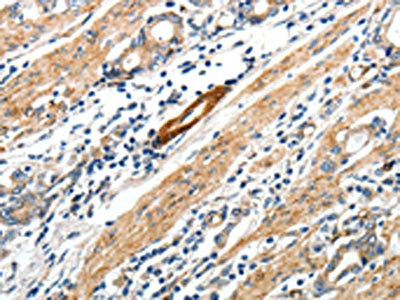
The image on the left is immunohistochemistry of paraffin-embedded Human lung cancer tissue using CSB-PA590264(STEAP4 Antibody) at dilution 1/25, on the right is treated with synthetic peptide. (Original magnification: x200)
STEAP4 Antibody

CSB-PA590264
ApplicationsWestern Blot, ELISA, ImmunoHistoChemistry
Product group Antibodies
ReactivityHuman
TargetSTEAP4
Overview
- SupplierCusabio
- Product NameSTEAP4 Antibody
- Delivery Days Customer20
- ApplicationsWestern Blot, ELISA, ImmunoHistoChemistry
- CertificationResearch Use Only
- ClonalityPolyclonal
- ConjugateUnconjugated
- FormulationLiquid
- Gene ID79689
- Target nameSTEAP4
- Target descriptionSTEAP4 metalloreductase
- Target synonymsmetalloreductase STEAP4; SchLAH; seven chromosome locus associated with HCC; six transmembrane prostate protein 2; six-transmembrane epithelial antigen of prostate 4; sixTransMembrane protein of prostate 2; STAMP2; STEAP family member 4; TIARP; TNFAIP9; tumor necrosis factor, alpha-induced protein 9; tumor necrosis-alpha-induced adipose-related protein
- HostRabbit
- IsotypeIgG
- Protein IDQ687X5
- Protein NameMetalloreductase STEAP4
- Scientific DescriptionThe protein encoded by this gene belongs to the STEAP (six transmembrane epithelial antigen of prostate) family, and resides in the golgi apparatus. It functions as a metalloreductase that has the ability to reduce both Fe(3+) to Fe(2+) and Cu(2+) to Cu(1+), using NAD(+) as acceptor. Studies in mice and human suggest that this gene maybe involved in adipocyte development and metabolism, and may contribute to the normal biology of the prostate cell, as well as prostate cancer progression. Alternatively spliced transcript variants encoding different isoforms have been found for this gene.
- ReactivityHuman
- Storage Instruction-20°C or -80°C
- UNSPSC12352203


